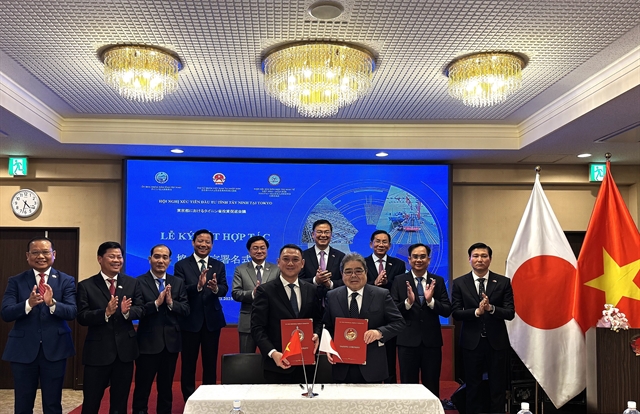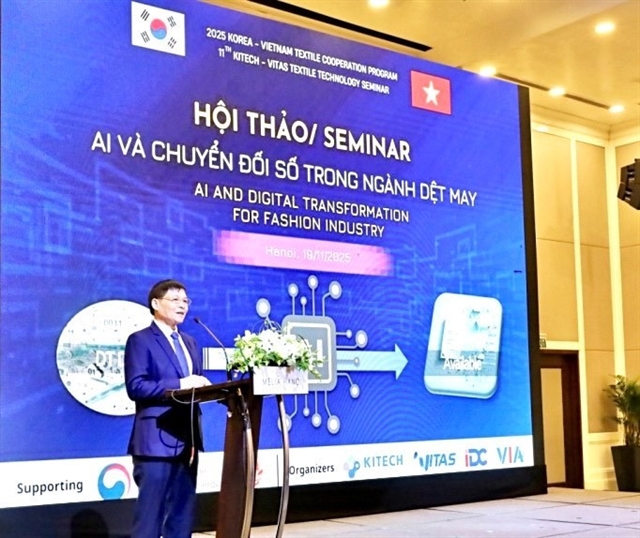 Economy
Economy

| A worker of Korea's Hana Micron Vina in Bắc Giang Province checks a wafer which is used to produce semiconductor products. — VNA/VNS Photo Tuấn Anh |
HÀ NỘI — A number of global semiconductor manufacturers are increasing their presence in Việt Nam, making the Southeast Asian country a rising star in the world semiconductor market.
South Korea’s Hanmi Semiconductor, one of the world-class leading manufacturers of semiconductor equipment, announced at the end of May that its branch, based in the northern province of Bắc Ninh, was officially put into operation.
Kwak Dong-shin, CEO at Hanmi Semiconductor, was quoted by Đầu Tư (Vietnam Investment Review) newspaper as saying that: “We believe that Việt Nam is emerging as a production hub for many semiconductor manufacturers.”
In early June 2023, Infineon Technologies AG, Germany’s largest company specialising in semiconductor solutions for power and IoT systems, announced the expansion of its operation in Việt Nam, together with the establishment of a chip development team in Hà Nội.
C. S. Chua, president and managing director of Infineon Technologies Asia Pacific, was quoted by the newspaper that with a population of around 100 million and a young population structure, Việt Nam was turning into a key market and destination for multinational co-operations to search for technical talents.
According to market research company Technavioa, the semiconductors market in Việt Nam was estimated to grow at a compound annual growth rate of 6.12 per cent between 2022-27. The size of the market was forecast to increase by US$1.65 billion.
Technavio’s report pointed out that the growing number of smartphone users was driving market growth. To meet the growing demand for smartphones, manufacturers in the region would open more factories in the country. About 40 different mobile phone brands, including Sony and Samsung, were exported from Việt Nam.
The market was also seeing an emerging trend of smart homes with devices such as cameras, sensors, control systems, mobile devices and automation systems which required semiconductors to function.
However, the lack of availability of skilled labour is a major challenge impeding market growth, according to the report.
Technavio said that several vendors wanted to move their semiconductor production lines to Việt Nam, particularly in light of the US-China trade dispute, resulting in the rise in the need for skilled workers with the knowledge and aptitude to produce semiconductors. However, the nation lacks professionals with the necessary skills and training.
According to Liu Xin, director of marketing of Laser Ibe Việt Nam, which had put a $15 million plan into operation at the end of March, Việt Nam is a wonderful country for investment thanks to the potential market and the support from the Government.
A recent report by the Bank of Korea pointed out that Việt Nam quickly emerged as a major market for South Korean semiconductor makers, which had been struggling amid sluggish ship demand in China.
"Việt Nam is emerging as a new source of demand for South Korean semiconductors, as it rises as an international production base for information technology (IT) devices that could potentially replace China in the future," the report wrote.
The report pointed out that Việt Nam had become home to major smartphone manufacturers’ production bases. And Korean semiconductors were used as intermediary goods in Việt Nam to produce finished IT products.
Việt Nam's abundant low-wage workforce and high accessibility to the Chinese market were prompting global businesses, including those from Korea, to build manufacturing facilities in the country, according to the report.
Nguyễn Khắc Giang from ISEA – Yusof Ishak Institution said that Việt Nam had the opportunity to enhance its position in the global value chain and transform from a labour-intensive model to an advanced technology-powered model from embracing the semiconductor industry development.
This transformation would help Việt Nam realise the ambition to reach a GDP per capita of over $18,000 by 2045, he said.
However, it was necessary to review the policy framework, strengthening vocational training for high-tech sector and increasing support for the domestic enterprises to promote the development of the semiconductor industry, he said.
Statistics of the Ministry of Information and Communications showed that Việt Nam’s chip industry earned revenue of $562.5 million from exporting to the US in 12 months ending in February, a rise of 74.9 per cent against the previous same period.
This meant that Việt Nam accounted for 10 per cent of semiconductor chip exports to the US in the period, ranking third after Malaysia and Taiwan. — VNS




